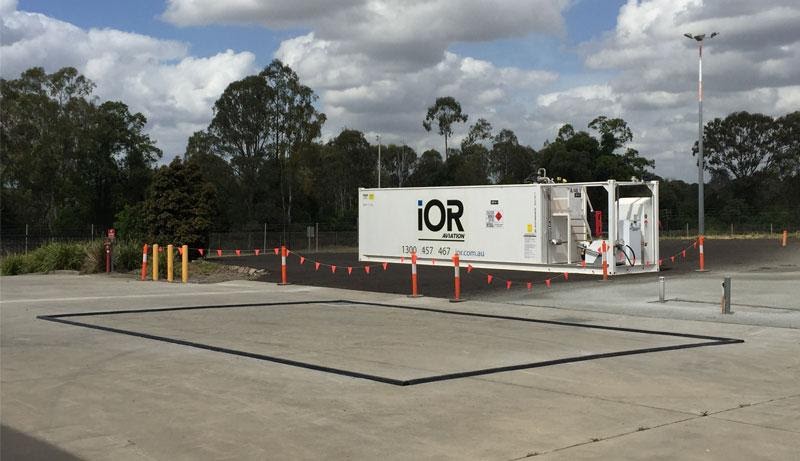With all the different types of spill bunds the markets offer, choosing the right one is not a matter of intuition. You have to know what you need – or get in touch with professionals. In this article, we will introduce you to the main types of spill bunds and their uses. You will gain expert advice on how to choose the right spill bund system for your business.
What is Bunding?
A Spill Bund, or simply bunding, is an impervious physical retaining barrier designed to safely contain spills – both common and dangerous ones. Bunding is widely accepted as an integral part of spill containment systems (SCSs). Bunding concept is simple yet highly efficient in preventing catastrophic situations.
The entire perimeter dedicated to acting as a spill containment area is commonly called ‘the bund.’
Bunding – the barrier that acts as a spill-preventing embankment – can be made from various materials – concrete, brick, stone, or synthetic. The materials used need to be resistant to the fluid in which they bund. For example, chemical storage.
However, the modern tendency is to have lightweight bunding made from new-generation durable synthetic materials – or a combination of materials. The synthetic bunding can be moved, easily cleaned, and allows for easy access and manipulation by employees and machinery.
Whatever the type of bunding, its walls must be tall enough to contain the largest possible spill, but it still has to be low enough so employees can easily work over it to handle the barrels, drums or containers, deal with the spill should one occur, or work unconstrained in general.
However, the exact design will depend on the needs of the user, the fluid volume of the largest most likely spill, the type of access required and the footprint size of the containers storing the fluid within – that is, your business requirements.
What types of bunding are out there?
Let’s find out.
What Types of Bunding Are Available?
Bunding can be classified in several ways: by material (concrete, brick, PVC, etc.), shape (ramp, hump, or square), mobility (portable or stationary), and flexibility (rigid/inflexible, or flexible bunds).
However, when choosing the right spill bund for your facilities, the first thing you need to consider is the application, which dictates the overall design and the type of spill bunding.
Here are the five main types of spill bunds we offer – they cover most retail, warehouse, and industrial needs.
Portable Bunding
The primary benefit of Portable bunding is mobility. It is ideal for temporary storage at remote locations, away from your main facilities. Therefore, it is commonly used in mining, oil, gas and other extraction industries and during various other field operations within the construction sector.
Portable bunds are made out of heavy-duty PVC, with the addition of reinforced battens for better stability and easy installations. They are quick to install and just as easy to pull down and fold away and require minimum storage space when not in use.
Image below shows 2 of our larger bunds set up in a warehouse and also on the pallet they were delivered on. Both bunds are 15m long.
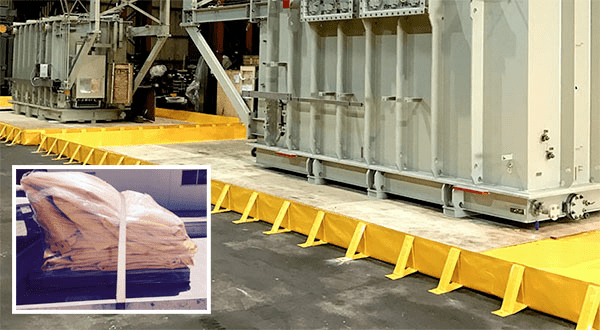
Ideal for: Any temporary relocatable storage use; mining, oil and gas industries.
Installation: Easy
Pros: Large capacity, easy to store when not in use, lower cost compared to permanent on-site construction bunds.
Cons: May need leveled ground.
Bunded spill pallets
As their name suggests, bunded spill pallets are highly durable, impervious, and resistant pallets that will contain potential spills coming from the drums placed upon them. They essentially work as holding utensils for liquid-containing barrels and drums. Bunded palettes are a versatile and highly popular type of bunding with a wide range of uses, especially in drum storage areas.
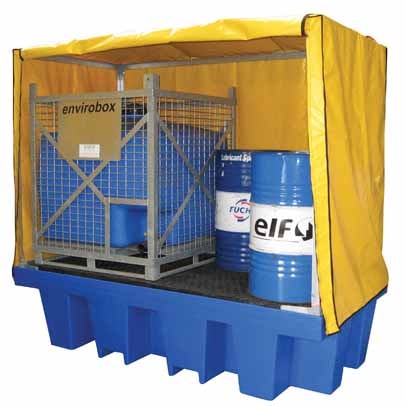
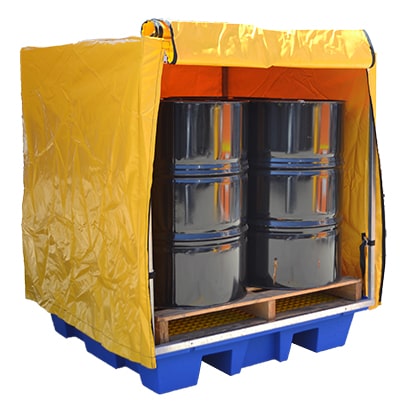
Compact and lightweight, bunded palettes can be easily stacked or nested when not used, ensuring efficient storage and transportation.
Bunded pallets are available in 2 or 4 drum configurations along with IBC and twin IBC (Intermediate Bulk Container). They are widely used for fuel and drum storage.
Ideal for: Warehouses and other storage facilities
Pros: 24-hour containment, compatible with forklifts, low cost and readily available
Cons: Requires slow movement if moving the pallets. If used out doors un roofed require a cover as per the images above.
Rubber Floor Bunding
Rubber floor bunds make for a classic type of stationary bunding, suitable for many applications where heavy vehicles are required to enter the bund. Such as transfer areas, washbays, warehouses and storage areas.
Also, this is one of the most durable types of bunding, designed to withstand heavy traffic and treatment over a long time. It has contoured edges that allow smooth vehicle entry and departures and reduce trip hazard for your employees. Our Rubber floor bund is unique in design, readily available and can be made in various color ranges to suit on site requirements when needed.
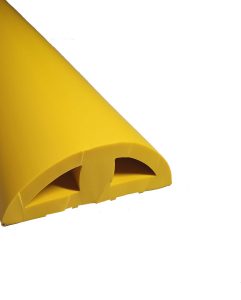
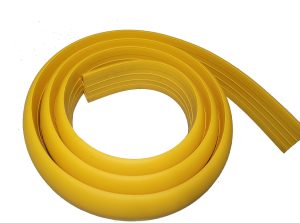
Rubber floor bunding is generally sold in 5m lengths and is easy to install in a short amount of time.
Ideal for: Warehouses, storage facilities, vehicle wash-bays.
Pros: Heavy-duty, long-lasting, looks tidy, straightforward to install.
Cons: Acts like a miniature speed bump and can reduce the speed and efficiency of vehicles if not using ramps.
Flexible Floor Bunding
Flexible bunds are made out of a durable but flexible material that allows vehicles to pass over it to, for example, move the drums. The material smoothly flexes under the wheels of the vehicle and springs right back into shape once the vehicle passes – all without uncomfortable bouncing and the need to get out and lower the wall to gain entry.
A flexible floor bunding is ideal for your facilities if you use forklifts or other machinery during your operations and in case working vehicles are your primary way of moving around the liquid-containing drums. It’s also available in 75mm and 100mm when the volume requirement of the bund needs to be a little more.
When it comes to spill containment, it is as effective as rubber floor bunding, but in factories and in warehouses, it ensures an optimal working speed by not slowing down the vehicles. However, flexible bunding might be shorter-lasting than its rigid rubber counterpart.
Ideal for: Warehouses and other high vehicle traffic indoor operations
Pros: Easily facilitates vehicle operation, smooth entry, and departure.
Cons: Less durable than rubber bunding, a little harder to install.
Temporary Bunding or Emergency Bunding
Temporary bunding is a quick short-term solution for leaks concerning drums or machines. It is made from PVC plastics, and it is fast and easy to assemble.
Also, temporary bunds are the cheapest bunding option on the list, but as stated, they are not ideal for permanent use or long-term storage. Rather, every business should have temporary bunds on hand to safely handle any surprise spills. They act like a spill tray.

Ideal for: Handling emergency spills within any operation
Pros: Very quick to set up, lightweight, affordable
Cons: Smaller capacity, not suitable for long-term storage
The 110% Rule
According to the Australian Standard for The storage and handling of flammable and combustible liquids, as well as the EPA’s Bunding and Spill Management Guidelines, the designed net capacity of a bund in a storage facility should be whichever is the largest of the following:
- At least 110% of the volume of the largest storage vessel; or
- At least 110% of the combined volume of any inter-connected vessels within a bunded area; or
- At least 25% of the total volume of all vessels stored in that bunded area
In common terms, the calculations are usually worked on 110% of the maximum most likely spill that needs to be allowed in the capacity – meaning that, for example, a 200L drum requires 220L bund capacity. It’s important to understand these requirements so you remain compliant with your storage bunds. nearly is not good enough.
Storage displacement
E.g- if I have a 200L drum I need a bund capable of handling 220L of fluid volume. if I place the 200L drum in a bund the drum itself displaces further volume and this is also an important calculation. If the drums displacement volume is 43L then the 43L is to be added to the 110% of the largest most likely spill to end up with a bund that in fact is compliant and and can handle the spill .. in the example above 220L + 43L = 110%
Find Your Perfect Spill Bund Solution
At Trade Environmental, hi-tech, modern, durable spill bund solutions of various types are exactly what we offer. The clever and well-thought-out designs ensure both maximum working efficiency and spill containment capabilities while respecting all technical standards and meeting legal requirements. We also enjoy chatting with the client, understanding the application and making sure we guide you the right way.
We hope that this article has equipped you with new applicable knowledge on spill bunding types. However, if you still have any doubts after reading it or would like to ask additional questions, don’t hesitate getting in touch with the team at Trade Enviro.

